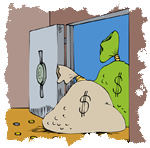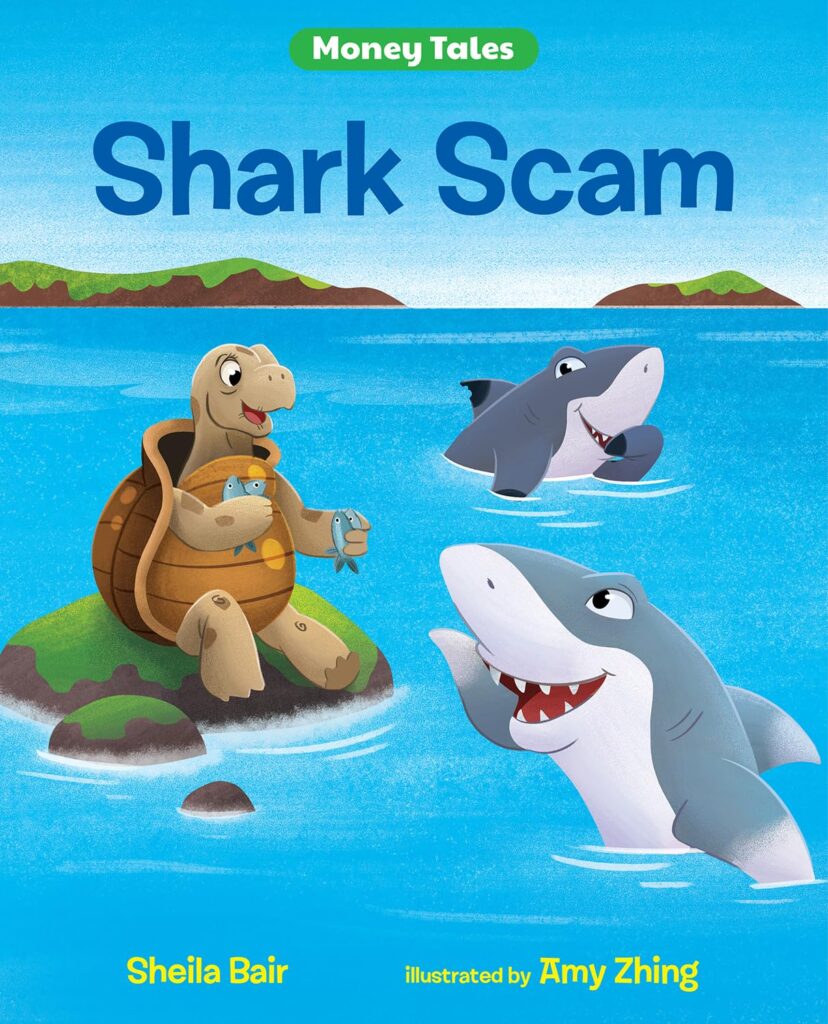
Grades 9-12

Don't have an account yet? Sign up for free
Don't have an account yet? Sign up for free


If you're a fan of old movies, you may remember a scene from It's a Wonderful Life in which the worried townspeople of Bedford Falls race to the community's Building and Loan Bank. They congregate outside of the bank's iron gates, which George Bailey's Uncle Billy has closed in a panic. When George arrives and opens the gates, the townspeople rush into the bank lobby, demanding to withdraw all of their funds. Uncle Billy says, "This is a pickle, George. This is a pickle." George tries to explain to the people that their money is tied up in their neighbors' homes, as an investment, and the bank has very little cash left to give out.
This scene depicts a bank failure — a "run on the bank" in which the bank couldn't meet the demands of depositors for the money they had deposited. Bank failures occurred frequently in the nineteenth century and early in the twentieth century. They hardly ever occur today. What caused the bank failures, and why are they now a thing of the past? You'll learn the answers to these questions in this lesson. Along the way, you'll learn some basic information about how banks work, how banks create money, and how the Federal Reserve uses monetary policy to influence the economy.
In this lesson you will learn why banks sometimes failed in the past. You will also take up some related questions. What happens to the money you deposit in the bank? What do banks do with your money? Answers to these questions will show that banks play a very important role in our economy. They aren’t there to just store your money and keep it safe. You will learn what else banks do, and how their activity is influenced by the Federal Reserve.
The famous movie scene summarized earlier in this lesson highlights an important fact about banks and banking: banks do not keep all of their customers' deposits on hand. Even your local bank does not keep enough cash on hand to satisfy all of its customers if they came in at the same time demanding to withdraw their deposits. Most of the money deposited by a bank's customers is not kept in the vault; instead most of it is lent out to other bank customers, to be used for productive purposes.
 This role of a bank, often called financial intermediation, is vital to the efficient workings of a market economy. Banks bring people together: people who have extra money (the lenders or savers) and people who need money (the borrowers or spenders). It is a very important service. It enables people to buy homes, to start new businesses, to go to college, or (in the case of loans to the local school district) to build a new state-of-the-art school.
This role of a bank, often called financial intermediation, is vital to the efficient workings of a market economy. Banks bring people together: people who have extra money (the lenders or savers) and people who need money (the borrowers or spenders). It is a very important service. It enables people to buy homes, to start new businesses, to go to college, or (in the case of loans to the local school district) to build a new state-of-the-art school.
How might people do these things if there were no banks? Consider the prospects of a young teacher trying to buy a $150,000 home. Perhaps, by diligently saving her money, she is able to acquire the $30,000 needed for a 20 percent down payment. In that case, she still needs $120,000 to purchase the home. Since she can't go to a bank to borrow the $120,000, she might seek loans from members of her family, friends and neighbors, maybe even co-workers. While she might possibly come up with all of the money she needs to buy the home in this way, each of these loans would almost certainly be negotiated with its own terms and conditions, and borrowing from friends and relatives might involve complicated personal issues. The costs of acquiring money in this manner is very high.
Today, as an alternative, we have banks that utilize something called a fractional reserve system. With a fractional reserve system, only a fraction of bank deposits is actually kept in the bank to satisfy customers who want to make withdrawals. The rest of the money is lent out to individuals, firms, municipalities, the federal government or other borrowers, to be used for productive purposes. The amount of money that banks keep on hand to satisfy withdrawals is called reserves. Reserves are held in the bank's vault or in an account at a Federal Reserve Bank. The Federal Reserve, also known as the Fed, mandates a required reserve ratio, typically around 10 percent of checking deposits, which banks must hold in reserve to provide liquidity and satisfy requests for withdrawals. The required reserve ratio has an effect on the country's supply of money.
Because banks use a fractional reserve system, it is often said that banks "create money." While this term may conjure  up images of a banker running a printing press in the bank basement, that is not how banks create money. To understand how banks do create money, we first need to understand how economists define money.Economists consider money to be anything that is generally accepted as payment for goods and services. That definition clearly includes cash and currency. However, it also includes checking accounts, since checks can be written on these accounts and used to pay for items that people purchase. So, how does a bank create money?
up images of a banker running a printing press in the bank basement, that is not how banks create money. To understand how banks do create money, we first need to understand how economists define money.Economists consider money to be anything that is generally accepted as payment for goods and services. That definition clearly includes cash and currency. However, it also includes checking accounts, since checks can be written on these accounts and used to pay for items that people purchase. So, how does a bank create money?
Consider the following scenario. Sally Saver goes to First National Bank and deposits $1,000 that she received as a gift from her grandparents. She now has a checking account with a balance of $1,000 from which she can write checks. What will First National Bank do with this newly deposited money? Well, if there is a 10 percent reserve requirement, they will put $100 in their vault and lend out the rest to people who want loans. Say Mike Inventor walks into First National Bank looking to borrow $900 to develop his next great invention. If the bankers decide that his project is worthwhile, they might give him the $900 he requests. If Mike puts the $900 in his checking account, he can then write checks for this amount. There is now $1,900 of money available ($1,000 in Sally's checking account and $900 in Mike's) for spending. In other words, $900 in new money has been "created." This process will continue over and over again as the bank lends out $810 of Mike's deposit while putting $90 in reserves — up to as much as $10,000. Our fractional reserve banking system leads to this multiplier effect on money.
Banks play an important role in the economy. They bring together people who have extra money and people who need money. In this lesson you learned what a fractional reserve system is and how banks utilize a fractional reserve system. This system creates money through the lending process.
Visit this Interactive Activity related to banking.
View this short video related to money creation.
 The Federal Reserve plays a role in controlling the supply of money. What is that role? To understand it, you need to know what the Red's main responsibilities include. A 1978 amendment to the Federal Reserve Act give the Fed responsibility for pursuing a number of goals for the nation's economy. Essentially, this Act states that the Fed should promote high employment, stable prices and sustainable economic growth. The Fed cannot guarantee that everyone will have a job or that inflation will remain under control; employment rates and inflation are influenced by the decisions of millions of firms and households interacting in the economy. However, the Fed can help create an environment in which these goals are more likely to be achieved. How does the Fed do this? The answer is through monetary policy. Through monetary policy, the Fed influences interest rates and the supply of money and credit, thus influencing the path of economic activity generally. The Fed does this by using three tools:
The Federal Reserve plays a role in controlling the supply of money. What is that role? To understand it, you need to know what the Red's main responsibilities include. A 1978 amendment to the Federal Reserve Act give the Fed responsibility for pursuing a number of goals for the nation's economy. Essentially, this Act states that the Fed should promote high employment, stable prices and sustainable economic growth. The Fed cannot guarantee that everyone will have a job or that inflation will remain under control; employment rates and inflation are influenced by the decisions of millions of firms and households interacting in the economy. However, the Fed can help create an environment in which these goals are more likely to be achieved. How does the Fed do this? The answer is through monetary policy. Through monetary policy, the Fed influences interest rates and the supply of money and credit, thus influencing the path of economic activity generally. The Fed does this by using three tools:
The most important tool of monetary policy, and the one most frequently used, is open market operations. Eight times per year, the Federal Open Market Committee (FOMC) meets to set interest rate targets. These meetings receive significant attention from many people, including people in the media, with post-meeting reports typically stating that the Fed "lowered interest rates," "raised interest rates," or "didn't change interest rates." Open market operations are the tool the Fed uses to make these interest rate changes.
While media reports on these Fed meetings make it sound as if the Fed can simply change interest rates, there is a bit more to it in practice. The Fed uses open market operations to control the federal funds rate — i.e., the interest rate that banks charge when one bank wants to borrow from another's reserves. While this may sound complicated, it really isn't. As we mentioned previously, banks are subject to a reserve requirement mandated by the Fed. In the earlier example, we assumed that banks were required to keep 10 percent of their checking deposits in reserve. Sometimes banks are either short of their required reserves, and sometimes they have excess reserves at the end of the day. When this happens, banks with extra funds can lend money through the Federal Funds Market, to banks that are short. In the Federal Funds Market, the borrower pays the federal funds rate.
The Fed influences the federal funds rate by buying and selling existing government bonds. When the Fed wants to lower interest rates, and encourage firms and individuals to borrow, it buys government bonds from securities dealers. In return for these bonds, the Fed credits these dealers' bank accounts at the Fed. This puts more money into the banking system and places downward pressure on the federal funds rate (increases the supply of money). Other interest rates in the economy then follow (like interest rates on car loans or homes), and borrowing becomes cheaper. This is typically done when the Fed is worried about the economy slipping into recession. The Fed then hopes that lower interest rates will encourage borrowing and keep the economy strong. On the other hand, the Fed can raise the federal funds rate by selling government bonds. By doing so, the Fed takes money out of the banking system (lowers the supply of money) and consequently raise interest rates. This is typically done when the Fed fears inflation. It is hoping to slow spending on goods and services by raising the costs of borrowing money.
As we have discussed, the Fed sets a percentage of checking deposits that banks must hold in reserves. In April of 1992, the Fed lowered this required reserve ratio from 12 percent to 10 percent. This tool of monetary policy has not been used since then. When the reserve requirement is lowered, banks are required to keep less money in reserves, and more money is created in the lending process. In other words, less money sits in bank vaults and more is in the hands of the public to use to purchase goods and services. Conversely, if the reserve requirement were raised, banks would have to hold more reserves and less money would be created in the lending process. Reserve requirements are infrequently changed by the Fed, primarily because of the impact that changes in reserve requirements would have on banks and their costs of doing business.
The final tool of monetary policy that the Fed can wield is called discount policy. Discount policy means changing the discount rate: the rate banks must pay to borrow from the Fed. By lowering this discount rate, the Fed can encourage borrowing; or the Fed can raise the discount rate and discourage borrowing. In either case, the money supply can be affected. While the discount rate is typically changed in conjunction with the federal funds rate, discount loans are rare. One reason for this is that the discount rate is kept higher than the federal funds rate, so that banks have no incentive to borrow in the discount market. Discount loans are most often used to bail out failing banks or to help banks that operate in agricultural markets where the most of their lending takes place during one part of the year. Discount loans can also be used during times of great financial market uncertainty (such as after September 11, 2001).
Look up the current reserve ratio, federal funds rate and discount rate on the Fed's web site page https://www.federalreserve.gov/monetarypolicy.htm.
Record the definitions and any other important information on this worksheet.

Grades 9-12

Grades 9-12

Content Partner
Grades 3-5

Grades 9-12
